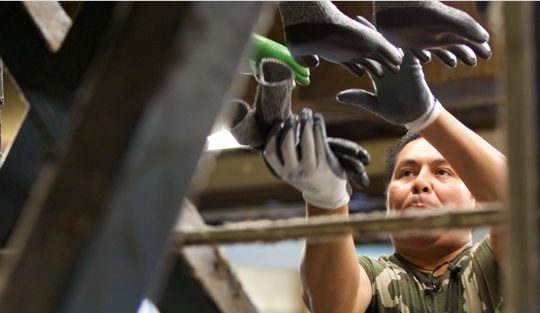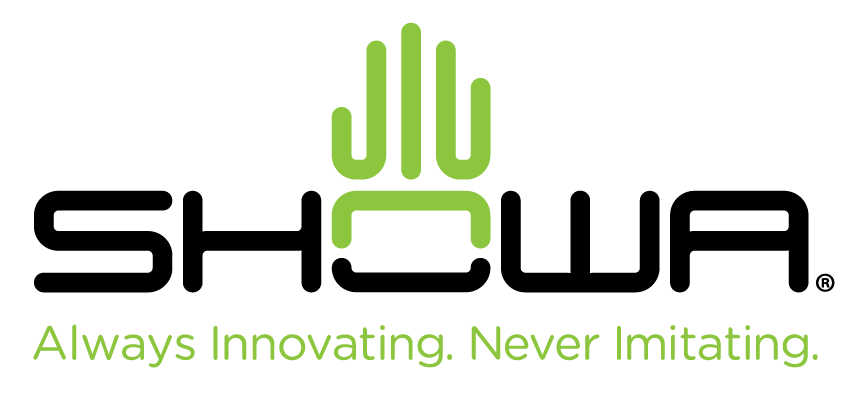- FIND GLOVES BY HAZARD
-
FIND GLOVES BY INDUSTRY
- Aerospace
- Agriculture
- Airports & Ports
- Automotive
- Chemical
- Clean room
- Commercial fishing
- Construction
- DIY
- Electronics
- Engineering
- Food
- Glass
- Healthcare
- Janitorial
- Laboratory
- Landscaping
- Manufacturing
- Mechanical
- Metallurgy
- Mining
- Municipal services
- Oil and gas
- Outdoor sports
- Packaging
- Pharmaceutical
- Printing
- Railways
- Utilities
- Warehousing & Distribution


It’s been over 30 years since SHOWA developed the world’s first batch of NBR (nitrile rubber) gloves, introduced as N-DEXS in 1991, as the world’s first disposable nitrile and was subsequently patented. Since then, nitrile gloves have become an affordable, effective material to be used across many different industries and use cases thanks to a number of features that overcome problems with similar gloves, like being hypoallergenic, unlike the latex material gloves, for example.
The global COVID-19 pandemic has seen an unprecedented impact on the Personal Protective Equipment (PPE) market, with protective gloves experiencing a higher-than-anticipated demand across all regions compared to pre-pandemic levels. Based on analysis from Fortune Business Insights, the global market experienced a significant growth of nearly 17% in 2020 as compared to 2019, and the forecast is a 4.6% compounded annual growth rate from $24.2Bn USD in 2022 to $33.3Bn USD by 2029.
In this article, we answer the five most commonly asked questions about nitrile gloves to help educate you on making the best choice of gloves to suit your needs.
Are nitrile gloves washable?
The answer depends on whether you are using reusable or single-use nitrile gloves, for example, the thicker and reusable type of nitrile gloves like SHOWA’s 707HVO and 708 products are, in fact, washable.
Under no circumstance should single-use nitrile gloves be washed and reused. This type of PPE is typically thinner and more dexterous than the reusable alternatives and are unsuitable for washing, decontamination or reprocessing. Trying to clean single-use nitrile gloves with cleaning solutions can weaken the protective characteristics of the gloves and put users at risk of spreading bacteria to patients, surfaces, foods and equipment etc.
The 707HVO nitrile gloves are SHOWA’s eco-friendly alternative to single-use gloves which doesn’t mean compromising on functionality either. The 707HVO gloves are highly tactile and fit like a second skin, all whilst protecting against grease, chemicals, and abrasion. These biodegradable nitrile gloves use our revolutionary Eco Best Technology® (EBT), making a difference to the environment, without any compromise in protection and performance, thus making them an environmentally conscious choice, breaking down by 82% in just 386 days when tested in a laboratory.
SHOWA’s 708 nitrile gloves are also washable alternative nitrile gloves that are designed for industries like chemical, food and mechanical yet still withholding grip and dexterity, providing superior control when working with liquids and during long periods of use.
It’s important to note that there are a few ways to clean nitrile gloves if they become dirty, not including contaminated liquids. Soaking the gloves in soap and hot water or using an anti-bacterial cleaner can all effectively do the trick. Always read the product label before using gloves to make sure they are safe for contact with food.
Are nitrile gloves latex-free?
Yes, nitrile gloves are latex-free using hypoallergenic synthetic rubber for those whose bodies mistake latex for a harmful chemical and cause symptoms that may include immediate itching, redness and swelling of the skin that touched the item containing latex (Source). Thanks to advances in manufacturing technology, nitrile gloves are thinner and more flexible so are well-regarded in the medical and healthcare industries.
A notable benefit of nitrile gloves over latex gloves stems in the strong robustness . Whilst nitrile gloves have become thinner and more flexible, they still attain a strong resistance to many chemicals, protecting against punctures and tearing. This is particularly important for medical and healthcare workers, where durability is equally, if not more important, than sensitivity.
Do nitrile gloves come in different colours?
Yes, nitrile gloves come in a variety of different colours including white, blue, black, purple and green. The colour choice of gloves isn’t just for aesthetic reasons, there are common uses for each colour depending on their environment and the use case. If you need help deciding on which colour nitrile gloves to use, then here’s a helpful guide to the common environments that customers use different coloured gloves for.
Let’s look at some of the popular colours
- White Nitrile Gloves
A common single-use glove colour, white is especially useful for first responders who need to see contaminants like blood, for example, and many emergency care practitioners use white gloves as a writing surface to note vital signs or other relevant information.White gloves are also found in cleanrooms, where if you have something on your gloved hand, you need to know. Thin and dexterous white nitrile gloves are used frequently. in situations where the user requires an extra protective barrier to avoid skin contact. In these critical situations, many people wear a white glove under a dark blue or black glove. If there is a puncture or tear, the contrasting white under-glove is visible.
- Dark Blue Nitrile Gloves
Blue is one of the most popular choices of gloves and you can’t go wrong with it, especially in medical or healthcare facilities like hospitals, care homes and dental surgeries, as a shade of blue is the most commonly used colour for nitrile gloves. Blue helps the staff differentiate these gloves from the typically white latex gloves. There are a lot of different shades of blue from dark, to light, to royal and they all have their appropriate applications. - Light Blue Nitrile Gloves
Blue powder-free nitrile gloves are the perfect choice for food preparation tasks, as they are food safe, highly detectable and cost-effective for single-use. The lighter blue colour variations of nitrile gloves is used extensively in food preparation environments mainly because there is no colour blue found in food so it’s easy to distinguish between the food being prepared and the glove when chopping. - Purple Nitrile Gloves
The colour purple has recently become popular in the medical space. As hospitals have begun to focus more on the overall patient experience, they have started to realise that the light blue colour makes interactions with patients feel “cold” and clinical, and understandably so! If you’re worried about your medical visit, purple hands are a lot more friendly looking by the first impression.But it’s not just the colour that’s the reason purple is a popular choice; they provide superior protection from bacteria, viruses, and chemicals where risk of fluid exposure is moderate to high. - Black Nitrile Gloves
Black is popular in automotive and mechanical facilities – or any workplaces where hands get dirty. Of course, it’s human nature to feel that you need to wash your hands when they are dirty or at least change your gloves. Dark gloves in black colour help alleviate this concern. You may have seen black nitrile gloves being popularised by tattoo artists too and the primary reason is simply because they fit their aesthetic!
Are nitrile gloves biodegradable?
Yes, nitrile gloves are biodegradable as a disposable product so long as they haven’t been contaminated with harmful chemicals or bodily liquids. In 2021, SHOWA was the first glove company to achieve the GreenCircle certification for 8 protective gloves from our range that meet all the necessary qualifications to be certified for the following claims: Biodegradable. The ASTM D5526 certification that SHOWA achieved demonstrated that the EBT gloves achieved 82% biodegradation in only 386 days, while gloves without EBT achieved only 1.9% biodegradation over the same period of time.
Our range of EBT Biodegradable Nitrile Gloves:
- SHOWA 7500PF Chemical Protection Glove »
- SHOWA 7502PF Chemical Protection Gloves (For Sensitive Skin) »
- SHOWA 6110PF Chemical Protection Gloves (Waterproof + Highly Dexterous) »
- SHOWA 6112PF Single-Use Gloves (Black Extreme Comfort) »
- SHOWA NSK24 Chemical Protection Gloves (Double Nitrile Coating) »
- SHOWA 731 Chemical Protection Gloves (Water-Resistant Bisque Grip) »
- SHOWA 707HVO Chemical Protection Gloves (Orange Food Contact Compliance) »
- SHOWA 707D Chemical Protection Gloves (Blue Second-Skin Feel) »
Proper recycled disposal of nitrile gloves helps protect the environment and keep our local and wildlife communities safe. When not properly disposed of, nitrile gloves can create pollution and harmful chemicals in the air when incinerated. Recycling nitrile gloves helps reduce the amount of these gloves that end up in landfills, too. And as a result, nitrile gloves are a valuable resource that due to their robustness should be used sensibly as single-use.
Are nitrile gloves good for food?
Yes, nitrile is one of, if not, the safest material for food contact yet some gloves are certified for food safety and some are not. Look for mentions of EU Standard, FDA, and Food Contact Compliance, which would mean that the gloves are third party certified to be food safe.
Nitrile is considered the material of choice for handling foods in a safe, contaminate-free and additive-free manner and the common colour of gloves used is light blue as there is no similar colour in foods. Certified nitrile gloves are used for their cleanliness and strength in food processing machinery, similarly, it is the safest and strongest material for food handling. Nitrile gloves’ robustness means there is a low chance of breakage and contamination. The colour of the glove also comes into consideration for food safety too.
–––––––––––––––
To find out more about how SHOWA can become your nitrile gloves partner of choice, please visit our contact page for details: http://www.showagroup.com/eu-en/contact





